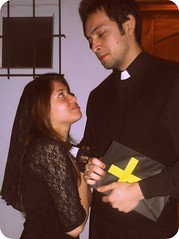I kept on writing in spite of my too-short and too-broken first novels. And as it turned out, the third time was the charm. This new project completely changed my writing career.
QUICK REMINDER: to receive your bonus reads for the book blast, you must email me your receipt! jordan at jordanmccollum.com
 Anyway. My best friend and I were chatting one day about a friend of hers who became a priest after college, and what it would be like to choose a celibate life at a young age. The conversation wandered off into paths of foreign soaps with Catholic priests pursued by young women (namely Ballykissangel and Abrázame muy fuerte). Sometimes these fictional priests would fall in love and leave the ministry, and my friend and I speculated what would happen if a priest fell in love.
Anyway. My best friend and I were chatting one day about a friend of hers who became a priest after college, and what it would be like to choose a celibate life at a young age. The conversation wandered off into paths of foreign soaps with Catholic priests pursued by young women (namely Ballykissangel and Abrázame muy fuerte). Sometimes these fictional priests would fall in love and leave the ministry, and my friend and I speculated what would happen if a priest fell in love.
That night, my mind returned to that theme. What if, I wondered, he wasn’t really a priest? For the first time, my mind went to what would later become my favorite fictional question: what if he were a spy?
I emailed my friend and within a day or two, we’d sketched out our stories and begun parallel novels: mine following the adventures of Father Undercover and the parish secretary, and my friend’s following the story of a teacher at the parish school (who happened to be Father Undercover’s sister) and a seminary candidate.
The book stats
Title: Finally settled on Saints & Spies
Genre: Romantic suspense (my first contemporary-set novel!)
Inspiration: a conversation with my best friend
Writing dates: 22 October 2008 – early December 2008. And then editing until February 2010. Seriously.
Length: Maxed out at 101,000, but submitted at around 90,000
Elevator pitch: An LDS FBI agent must go undercover as a Catholic priest to root out the mob in the parish—if he doesn’t fall for the parish secretary first.
What I learned from writing this book
Man. What didn’t I learn from this book?
From the initial writing, I was reminded what it was like to fall in love with a story. It had been nearly a year since I’d started a new project, and my enthusiasm for my previous books was as mired down as their plots. I realized I could write a book in a contemporary setting, and I learned how much fun it was to co-author. The best part was always writing the scenes with all four of our main characters interacting. My friend and I still squabble like our sibling characters when talking about a scene where they have opposite agendas 😉 .
But probably the farthest-reaching lesson I learned was how useful plotting really is. With four MCs, two main plots, intersecting subplots, shared scenes, etc., planning out our stories in advance was a must. The actual plotting took me less than a day and I was still very excited about the story. The actual book was very different from the original plot—we cut the rival mob that was the main plot entirely—but having a guideline in place was an amazing revelation. It didn’t stifle my creativity; the outline enabled it.
This book became my first submission, and thus my first rejection. That, right there, says a lot.
I would not give up. Editing the book again taught me more than I’d ever learned about writing. I went through each scene to perform a tension check, ensuring there was some source of tension in the scene, striving to weave in more interactions with antagonists, bringing out the suspense. I took my heroine from a crying waif to a proactive former policewoman. I learned how to better write character emotions from the inimitable Margie Lawson.

I learned how much real work it would take to get that book from first draft to publishable (my secret sauce of writing). It took more than a year of work after the rejection to get it that way.
After I finally learned what editing was, this book became my first contest win. Then it became my first acceptance from a publisher. And one day, it will definitely be available. Once upon a time, that day was going to be last month, but it isn’t now. Which is okay, too—because if you saw the dates above, I started this book five years ago and often I’m not sure I want to look back at where my writing was back then!
But, hey, if you do, you can read that prizewinning chapter right here on my website.
What do you think? How did you learn about the importance of planning, or editing? How many novels did you write before you had one ready to submit?
Photo credit: el Padre y la Viuda (the Father and the Widow)—Carlos MuLec


Writing the third right now! I only just started, but I feel this is the one for submission. Thanks for the motivation for the long-haul.
Such a fun premise. I hope to see it soon.